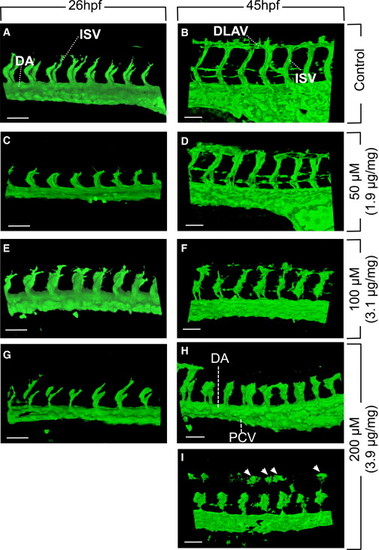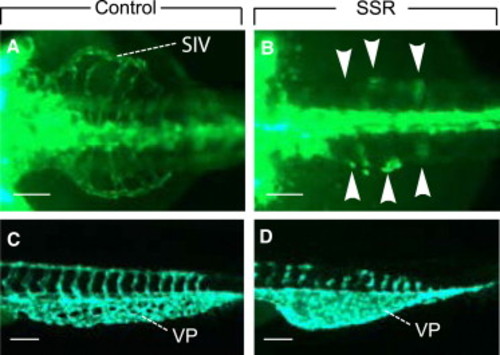- Title
-
Fibroblast Growth Factor Signaling Affects Vascular Outgrowth and Is Required for the Maintenance of Blood Vessel Integrity
- Authors
- De Smet, F., Tembuyser, B., Lenard, A., Claes, F., Zhang, J., Michielsen, C., Van Schepdael, A., Herbert, J.M., Bono, F., Affolter, M., Dewerchin, M., Carmeliet, P.
- Source
- Full text @ Chem. Biol.
|
FGFR Expression in Zebrafish Embryos (A and B) Endothelial expression of FGFRs was determined by real-time RT-PCR analysis of GFP+ ECs isolated by flow cytometry from 24 hpf Tg(fli1:EGFP)y1 and Tg(flk1:EGFP) zebrafish embryos. Data are mean ± SEM. (C–F) Whole-mount in situ hybridization of 24 hpf embryos revealed that fgfr1 and fgfr2 were expressed in the DA, PCV, intersegmental vessels (ISVs; arrows) and vascular plexus (VP) in the ventrocaudal tail, while expression of fgfr3 in these vessels was less pronounced. The inset in C and D displays a higher magnification of the fgfr1- and fgfr2-positive ISVs (red boxed ares). Fgfr3 and fgfr4 are both present in the vascular plexus (VP), while fgfr3 is faintly expressed in the DA, and fgfr4 is expressed in the caudal somites. Fgfr4 was mainly present in the vacular plexus at 24 hpf. Scale bars denote 100 µm in (C)–(F). EXPRESSION / LABELING:
|
|
FGFR Expression in Zebrafish Embryos (A and B) Endothelial expression of FGFRs was determined by real-time RT-PCR analysis of GFP+ ECs isolated by flow cytometry from 24 hpf Tg(fli1:EGFP)y1 and Tg(flk1:EGFP) zebrafish embryos. Data are mean ± SEM. (C-F) Whole-mount in situ hybridization of 24 hpf embryos revealed that fgfr1 and fgfr2 were expressed in the DA, PCV, intersegmental vessels (ISVs; arrows) and vascular plexus (VP) in the ventrocaudal tail, while expression of fgfr3 in these vessels was less pronounced. The inset in C and D displays a higher magnification of the fgfr1- and fgfr2-positive ISVs (red boxed ares). Fgfr3 and fgfr4 are both present in the vascular plexus (VP), while fgfr3 is faintly expressed in the DA, and fgfr4 is expressed in the caudal somites. Fgfr4 was mainly present in the vacular plexus at 24 hpf. Scale bars denote 100 µm in (C)-(F). |
|
Inhibition of FGFRs Results in Reduced VE-Cadherin Junctions Immunostaining of whole-mount zebrafish embryos for VE-cadherin (A and D, or red in C and F), showing intact and continuous EC-cell contacts in control-treated Tg(fli1:EGFP)y1 zebrafish embryos at 49 hpf (A–C), while SSR-treated zebrafish (exposure to 75 μM in the swimming water; tissue concentration 2.4 μg SSR/mg protein) (D–F) had a discontinuous VE-cadherin lining with reduced VE-cadherin-positive EC-cell juctions, explaining why ECs became disconnected from each other. |
|
Role of FGFs in Other Angiogenesis Processes in Zebrafish (A and B) Fluorescent images (ventral view) of GFP+ subintestinal vessels (SIVs) on the surface of the yolk sac of 72 hpf Tg(fli1:EGFP)y1 zebrafish embryos, revealing normal SIVs after exposure to DMSO (A) and severe underdevelopment of these SIVs after exposure to 50 μM SSR (tissue concentration 1.9 μg SSR/mg protein) from 20 hpf onward (arrowheads in B). (C and D) Images (lateral view) of the GFP+ vascular plexus (VP) in the posterior trunk of 45 hpf Tg(fli1:EGFP)y1 zebrafish embryos. In DMSO treated control embryos (C), a vascular plexus formed via branching from the caudal vein. After exposure to 200 μM SSR (tissue concentration 3.9 μg SSR/mg protein) from 20 hpfs onward, the vascular plexus failed to remodel and branch and, instead, only a large vascular syncytium was formed (D). In all panels, the head of the embryo faces left; scale bars denote 50 μm in (A) and (B) and 100 μm in (C) and (D). EXPRESSION / LABELING:
PHENOTYPE:
|
|
Inhibition of FGFRs during Fin Regeneration in Adult Zebrafish (A and B) GFP+ vessels in the fin of adult Tg(fli1:EGFP)y1 zebrafish at 7 days after amputation (dpa) of the ventral fin. The amputation line is indicated by a white dotted line. Note the impaired vessel regeneration in the SSR-treated fish (B). The white double arrow denotes the outgrowth length of the new blood vessels in the regenerated fin. (C and D) Morphometric quantification of the GFP+ vessel area (C) or the overall tissue (D) in the regenerating fin of adult Tg(fli1:EGFP)y1 zebrafish, showing that SSR inhibited vessel regeneration by 40% and tissue regrowth by 33% (data are mean ± SEM. N = 7 per group; p < 0.01 by ANOVA repeated measurements. p < 0.05 versus control at each time point by t test). Scale bars denote 250 μm in (A) and (B). |





